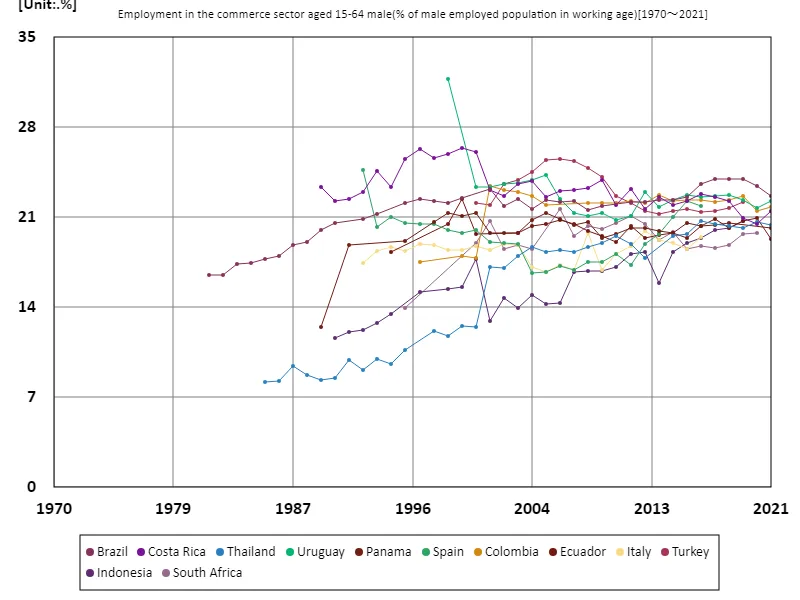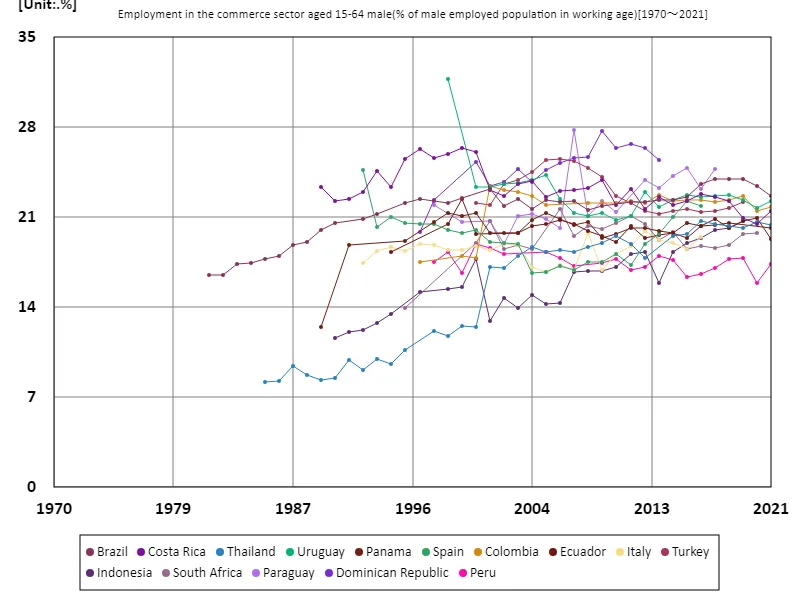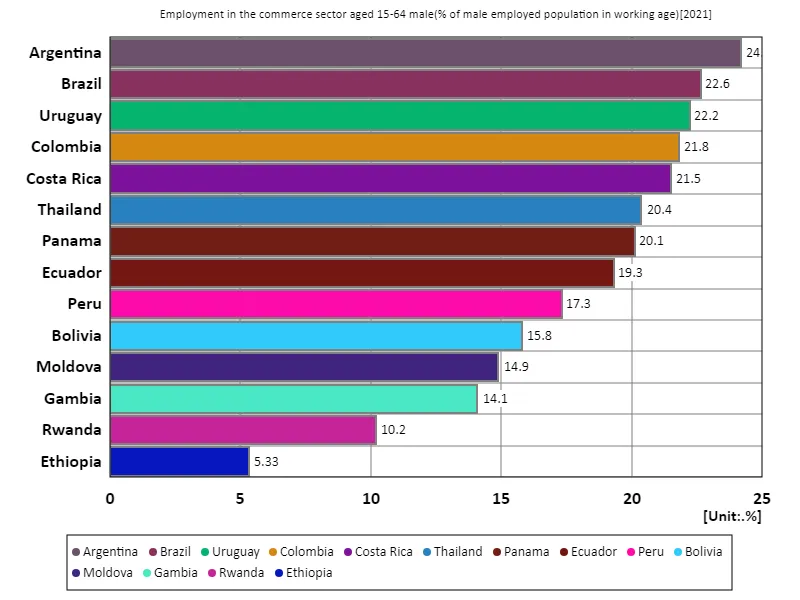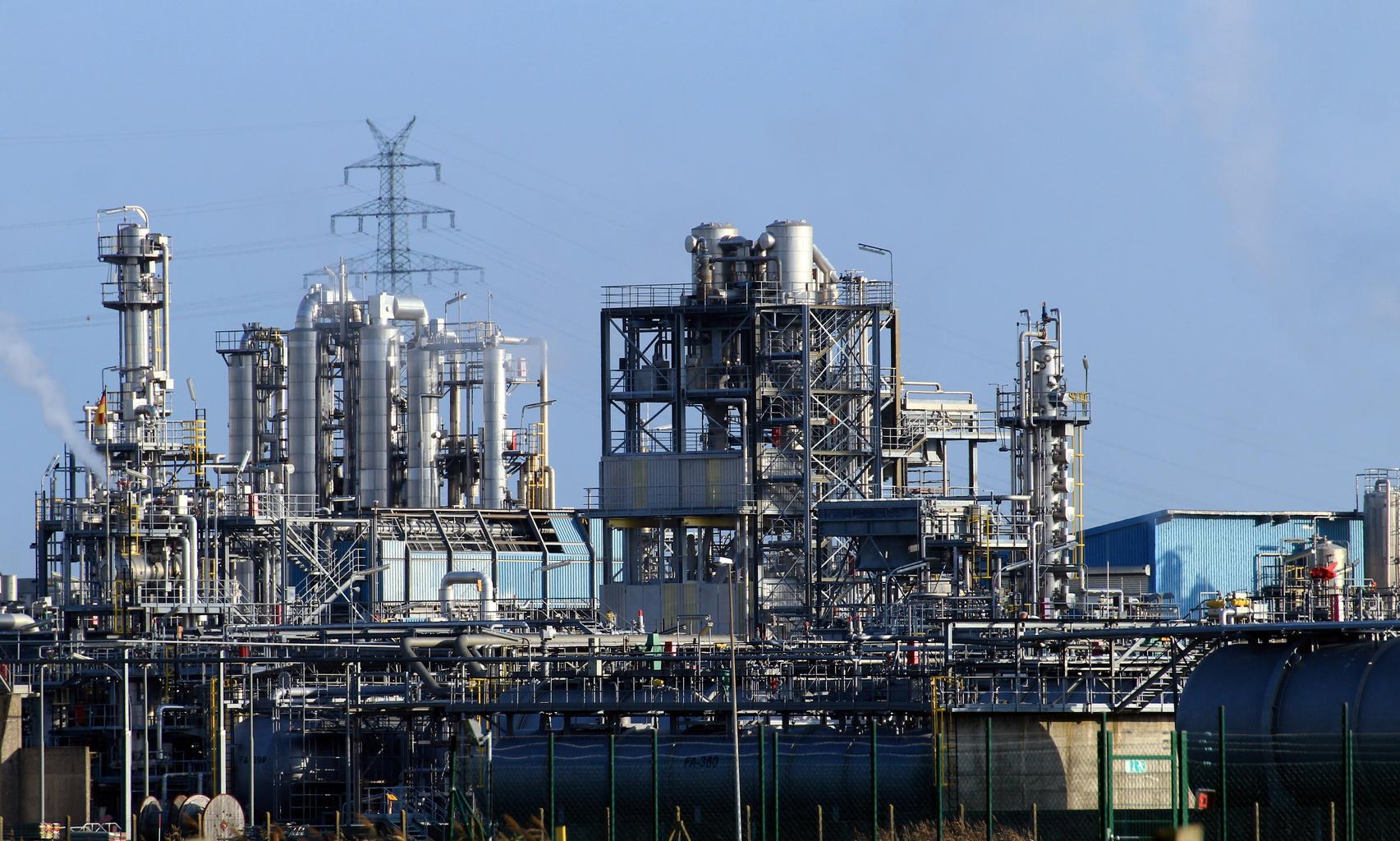- Abstract
- Employment rate in the trade sector for men aged 15-64 (percentage of working-age males in the workforce)
- Employment rate in the trade sector for men aged 15-64 (percentage of working-age male employed population) (Worldwide)
- Employment rate in the trade sector for men aged 15-64 (percentage of working-age males in the labour force) (world, latest year)
- Reference
Abstract
The high employment rate of 22.6% among men aged 15-64 in Brazil’s commercial sector is due to several factors. In recent years, Brazil has seen a marked diversification of its economy and an expansion of commercial activity, particularly in small and medium-sized enterprises and the commercial services sector. This has resulted in increased employment opportunities in the commercial sector, resulting in relatively high employment rates. Furthermore, the Brazilian labor market offers relatively accessible work environments in the commercial sector, making it an attractive option, especially for young and transitional workers. On the other hand, the high employment rate in Brazil’s trade sector may also be linked to challenges such as low employment in other sectors and an unstable economic situation. These factors combine to produce impressive employment rates in Brazil’s trade sector.
Employment rate in the trade sector for men aged 15-64 (percentage of working-age males in the workforce)
Uruguay’s employment rate in the trade sector for men aged 15-64, 31.8 percent in 1998, reflected the country’s economic growth and revitalization of its trade sector. During this period, Uruguay underwent economic reforms and saw a notable expansion of the commercial sector, resulting in high employment rates. However, over the next two decades, employment in Uruguay’s trade sector has declined, settling at around 70% of its peak in 2021. There are several possible factors behind this decline. First, economic globalization and technological progress have brought about changes in the commercial sector and altered labor market demands. The advancement of digitalization has transformed the nature of commercial activity and altered traditional employment structures. Additionally, economic instability and fluctuations have also affected employment in the commercial sector. Additionally, Uruguay is diversifying its economy, growing beyond the trade sector and shifting its labor market. These factors have combined to cause employment in Uruguay’s trade sector to decline significantly from its peak, although the sector remains an important source of employment.


The maximum is 31.8%[1998] of Uruguay, and the current value is about 70%
Employment rate in the trade sector for men aged 15-64 (percentage of working-age male employed population) (Worldwide)
The high employment rate in the trade sector among men aged 15-64 in Uruguay in 1998 (31.8%) reflects the economic growth and expansion of the trade sector at that time. During this period, Uruguay’s economy underwent market reforms and the commercial sector boomed. However, 2021 has seen a notable decline from this peak of 70%. There are several factors behind this decline. First, since 1998, globalization and technological innovation have brought about changes in the commercial sector, leading to a rethinking of traditional employment patterns. The increased adoption of digital technologies, in particular, has made business processes in the commercial sector more efficient while at the same time changing the structure of employment. Economic instability and fluctuations in the business climate have also affected employment in the trade sector, likely contributing to its decline from its peak levels. Furthermore, Uruguay has diversified its economy and grown its non-trade sectors, broadening its labour market and increasing employment opportunities outside the trade sector. This has resulted in a relative decline in employment in the commercial sector, although the commercial sector remains an important source of employment.


The maximum is 31.8%[1998] of Uruguay, and the current value is about 70%
Employment rate in the trade sector for men aged 15-64 (percentage of working-age males in the labour force) (world, latest year)
In 2021 data, Argentina recorded the highest employment rate in the trade sector for men aged 15-64 at 24.2%, while the overall average was 17.8%. This indicates that Argentina maintains a relatively high employment rate in the commercial sector. Argentina’s high commercial employment rate reflects the importance of commercial activity and the wide range of employment opportunities it offers. The trade sector plays a central role in the country’s economy, with small and medium-sized enterprises and retail businesses in particular providing many jobs. In contrast, the overall average of 17.8% indicates that while the trade sector has some importance in global labour markets, regional differences do exist. In addition, the total figure of 250% suggests that there is a large variation in employment rates in the trade sector among countries when making international statistical comparisons and compiling data, and that the economic situation and the level of development of the trade sector in each region have a significant impact on employment rates. Argentina’s high employment rate is testament to the importance of the trade sector in the economy and stands out when compared to other countries.


The maximum is 24.2% of Argentina, the average is 17.8%, and the total is 250%



Comments